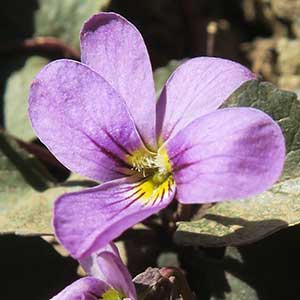Viola flettii
Viola clauseniana
Flett's violet, Olympic violet, rock violet
Clausen's violet
1–3, ascending to erect, mostly glabrous, on caudex from fleshy rhizome.
basal and cauline;
basal: 1–3;
stipules linear-lanceolate, margins entire or with glandular processes, apex acuminate;
petiole 1.5–9.7 cm, mostly glabrous;
blade purple-tinted and –veined, broadly reniform to ovate, 0.9–2.4 × 1.2–4 cm, base cordate, margins finely crenate-serrate, eciliate, apex acute to obtuse, surfaces glabrous or sparsely pubescent along veins adaxially;
cauline similar to basal except: stipules ovate to lanceolate, margins entire or shallowly laciniate;
petiole 0.7–5.9 cm, usually glabrous;
blade 0.8–2.1 × 1.2–3.1 cm.
basal, 2–10, often prostrate, sometimes ascending;
stipules narrowly lanceolate, margins faintly glandular-toothed, apex acute or obtuse;
petiole 5–11 cm, glabrous;
blade unlobed, ± deltate, 3–5 × 4–5 cm, base ± truncate, margins serrate, ciliate or eciliate, apex obtuse, surfaces usually glabrous, sometimes sparsely pubescent abaxially.
1.8–7.1 cm, usually glabrous.
8–14 cm, glabrous.
sepals lanceolate, margins eciliate, auricles 0.5–1.5 mm;
petals soft reddish violet on both surfaces, all with yellow area basally, lower 3 dark violet-veined, lateral 2 bearded, lowest with white around yellow area, 10–15 mm, spur yellow, gibbous, 0.5–2 mm;
style head bearded; cleistogamous flowers axillary.
sepals lanceolate to ovate, margins eciliate or ciliate around auricles, auricles 1–2 mm;
petals light violet on both surfaces, lower 3 purple-veined, all beardless, lowest petal 8–20 mm, spur white, gibbous, 2–3 mm;
style head beardless; cleistogamous flowers on prostrate to ascending peduncles.
± spherical, 5–9 mm, glabrous.
oblong, 8–10 mm, glabrous.
dark brown to brownish purple, 2.5–3 mm.
dark brown to black, 1.2–2 mm.
= 44.
Viola flettii
Viola clauseniana
Viola flettii is endemic to the Olympic Mountains of northwestern Washington. C. S. McCreary (2005) noted that although morphologically and ecologically distinct, V. cuneata, V. flettii, and V. ocellata are closely related.
(Discussion copyrighted by Flora of North America; reprinted with permission.)
Of conservation concern.
Viola clauseniana is endemic to Zion National Park, Washington County. M. S. Baker reported that its seeds were minutely roughed, a characteristic not recorded for other Viola species. Viola clauseniana was originally thought to be closely related to the acaulescent blue violets, most notably V. nephrophylla (S. L. Welsh et al. 1987; L. E. McKinney 1992). After contemplating the 2n = 44 chromosome count obtained by J. Clausen (1964), H. E. Ballard (pers. comm.) suggested that V. clauseniana might be more closely related with the stemless white violets (for example, V. blanda) than with V. nephrophylla. Viola clauseniana was considered a distinct species by N. H. Holmgren (2005d) and T. Marcussen and T. Karlsson (2010).
(Discussion copyrighted by Flora of North America; reprinted with permission.)


